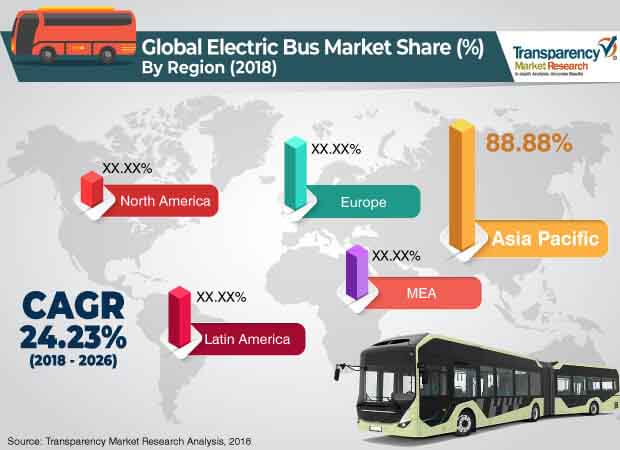
The electric bus market is expected to surpass US$ 165 Bn by 2026, expanding at a CAGR of more than 24% during the forecast period. The market for electric buses is anticipated to expand at a significant growth rate during the forecast period, owing to rising concern of society toward the environment.
The electric bus market is primarily driven by stringent emission norms across the globe. Rising emphasis by governments on public transport is anticipated to play an important role in the rapid expansion of the global electric bus market. Rising pollution levels in some mega cities, such as Shenzhen, London, Mexico City, Milan, Vancouver and Los Angeles, has already driven the market for electric buses significantly. Moreover, all the highly populous cities are likely to adopt electric buses to reduce greenhouse gases and other major pollutants in the environment. According to the World Health Organization (WHO), air pollution has been a major factor responsible for deaths and hospital admissions, thus the respective governments of countries in Europe are taking various steps to improve air quality, among which electrification of the automotive industry is a key step. The high price of electric buses has been a key restrain to the electric bus market; however, the price of buses has reduced due to significant reduction in the price of batteries in the last four years. Electric buses can be a value for money product in the long run, owing to lower running cost and higher lifespan of these vehicles, as compared to those vehicles that run on conventional fuels. Lower vibration from electric motors is a key factor behind the longer lifespan of electric vehicles.

Request for a sample:
https://www.transparencymarketresearch.com/sample/sample.php?flag=S&rep_id=44898
Governments of all highly polluted and populated cities are likely to adopt electric buses at the earliest. The responsible authorities have been offering considerable subsidies in order to enhance the adoption of electric buses across the globe and to encourage private firms and organizations to adopt electric buses instead of conventional buses.
In terms of electrification type, the battery electric buses segment dominated the global electric bus market in 2017, owing to the presence of a large number of battery electric buses in China. Shenzhen, a city in China, alone holds a larger fleet of battery electric buses than the total fleet of buses in major states of North America. If we exclude the electric bus market of China, the hybrid bus segment (Conventional Hybrid Bus) is expected to hold a major share of the market, as conventional hybrid is an older technology and has been already introduced in most regions across the globe; however, the technology is still in the nascent phase in several countries of Asia Pacific, which in turn is likely to propel the conventional hybrid buses segment of the market. The battery electric buses segment is likely to expand at a rapid pace, among all the segments, due to zero emission from these vehicles and high demand for battery electric vehicles. Asia Pacific and North America are likely to be highly lucrative markets for electric buses during the forecast period owing to rising stringency of emission norms in these regions.
In terms of bus type, the medium bus segment held a notable share of the market in 2017. The segment is likely to expand at a remarkable pace during the forecast period owing to medium buses possessing the precise length suitable for transit bus service. Furthermore, high seating capacity bus segment is likely to expand at a rapid pace during the forecast period as the high seating capacity buses are the most effective solution to contribute maximum for reducing the air pollution with optimum use power generated within the powertrain. Moreover, high seating capacity buses are of 18 m or 24m in length and are primarily gaining popularity in Europe and Americas.
In terms of battery, Lithium Iron Phosphorus battery is used in highest quantity. The lithium iron phosphate battery is preferably used in medium and large buses due to its excellent thermal stability, long lifespan, and faster charging time, as compared to that of the conventional lithium ion battery. Other battery types, such as lithium titanate and nickel manganese cobalt, are preferably utilized by some manufacturers in their light and medium buses, thus the lithium titanate and nickel manganese cobalt are anticipated to witness considerable expansion during the forecast period. Furthermore, various researches are being carried out on autonomous electric buses; however, the arrival of autonomous electric buses is expected after 2024, with limited production.
Ask for brochure:
https://www.transparencymarketresearch.com/sample/sample.php?flag=B&rep_id=44898
In terms of region, Asia Pacific holds a major share of the global electric bus market, followed by Europe. In Asia Pacific, China accounted for a prominent share owing to the considerably large electric bus fleet in Shenzhen. China alone held more than 85% share of the market in Asia Pacific in 2017. It sold more than 90,000 electric buses that contributed it to the notable share of the electric buses market in the region. Europe is an emerging market for electric buses, and countries such as Poland, the Netherlands, and France are focusing to replacement of their bus fleets with electric buses and hence, are promising markets for electric buses.
Major players operating in the global electric bus market are BYD Company Ltd., Yutong, New Flyer Industries Inc., Proterra Inc., Solaris Bus & Coach SA, Zhongtong Bus Holding Co., Ltd, Shenzhen Wuzhoulong Motors Co., Ltd, EBUSCO BV, Dongfeng Automobile Co., Ltd., Alexander Dennis, King Long, FAW Group, AB Volvo, Daimler AG, TATA Motors, Ashok Leyland, Nova Bus, and Foton Motor Inc. BYD Company Ltd. and Yutong with their presence in China dominated the global electric bus market, owing to high demand for electric buses in China. Furthermore, other players involved in the manufacturing of the conventional buses are likely to enter the electric bus market and encourage a healthy competition among all manufacturers.
Read TMR Research Methodology at: https://www.transparencymarketresearch.com/methodology.html
Read Our Latest Press Release:
- https://www.prnewswire.com/news-releases/rapid-adoption-of-cloud-based-platforms-to-benefit-companies-in-the-global-tax-software-market-whilst-outbreak-of-covid-19-to-accelerate-use-of-digital-platforms-for-tax-filing-processes-tmr-301249303.html
- https://www.prnewswire.com/news-releases/advantages-of-precise-allocation-of-energy-costs-for-commercial-residential-establishments-spurs-growth-in-electric-sub-meter-market-digital-metering-solutions-witness-substantial-uptick-in-demand—tmr-301243186.html
- https://www.prnewswire.com/news-releases/scrap-metal-recycling-market-to-emerge-robust-from-headwinds-of-covid-19-market-projected-to-expand-at-notable-6-cagr-from-2020—2030-301239593.html





